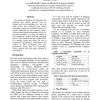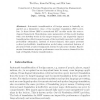16 search results - page 2 / 4 » Portuguese-English Word Alignment: some Experiments |
ACL
1998
13 years 7 months ago
1998
We present an algorithm for bilingual word alignment that extends previous work by treating multi-word candidates on a par with single words, and combining some simple assumptions...
AIRS
2004
Springer
13 years 11 months ago
2004
Springer
Abstract. Automatic transliteration of foreign names is basically regarded as a diminutive clone of the machine translation (MT) problem. It thus follows IBM’s conventional MT mo...
WWW
2010
ACM
13 years 5 months ago
2010
ACM
Sentiment classification aims to automatically predict sentiment polarity (e.g., positive or negative) of users publishing sentiment data (e.g., reviews, blogs). Although traditio...
ACL
2006
13 years 7 months ago
2006
In this paper we present word sense disambiguation (WSD) experiments on ten highly polysemous verbs in Chinese, where significant performance improvements are achieved using rich ...
COLING
1996
13 years 7 months ago
1996
A method for extracting lexical translations from non-aligned corpora is proposed to cope with the unavailability of large aligned corpus. The assumption that "translations o...


